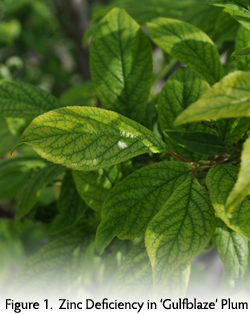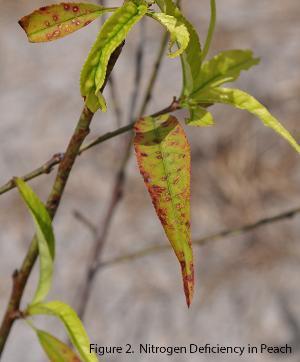Nutrition
Ensuring proper nutrition and applying fertilizer is important for the success of orchard establishment and to prolong a productive tree. Many of the standards and recommendations for Florida are derived from other states in the Southeastern United States Region (Table 1), and our program is currently examining recommended rates to examine the impact of these rates on fruit quality and size.
Table 1. Recommended Nutrition Ranges for Peaches (Georgia).
Elements needed in larger quantities (macronutrients) are reported in (% dry weight), while those needed in smaller amounts (micronutrients) are reported in parts per million (ppm).
| Nutrient | Deficient Level | Sufficient Range |
|---|---|---|
| N (%) | <1.7 | 2.75 - 3.50 |
| P (%) | <0.11 | 0.12 - 0.50 |
| K (%) | <0.75 | 1.50 - 2.50 |
| Ca (%) | <1.0 | 1.25 - 2.50 |
| Mg (%) | <0.20 | 0.25 - 0.50 |
| Mn (ppm) | <20 | 20 - 150 |
| Fe (ppm) | ----- | 60 - 400 |
| B (ppm) | <20 | 20 - 45 |
| Cu (ppm) | <3 | 5 - 20 |
| Zn (ppm) | <12 | 15 - 50 |
| S (%) | <0.01 | 12 - 40 |
Soil Sampling
Before the orchard is established, take soil samples that are representative of the plot of land. Samples should be taken evenly across the plot; unless it is known that there are areas of different composition. These different areas should be kept separate and will be amended as necessary according to soil testing.
To find out what your soil type and distribution is, check out the USDA-NRCS Web Soil Survey website. This site provides information previously published in soil survey books and is available in a web-friendly format.
The University of Florida has an Extension Soil Testing Laboratory for processing soil samples, while several other private laboratories will also do soil testing.
 Prior to planting, amend the soil as necessary as large changes in soil nutrition status are much easier to incorporate before trees are present in the row. Often, soils in Florida are acidic, and incorporation of lime will help to increase the soil pH. Ideal pH for stone fruit production is 6.0 to 6.5. Soil type will play a large part in choosing a fertilizer formulation; on heavier soils, a balanced mixture is recommended (8-8-8 or 10-10-10), while on sandy soils, reduced amounts of phosphorus and potassium are recommended (e.g., 12-4-8; Tables 2-5).
Prior to planting, amend the soil as necessary as large changes in soil nutrition status are much easier to incorporate before trees are present in the row. Often, soils in Florida are acidic, and incorporation of lime will help to increase the soil pH. Ideal pH for stone fruit production is 6.0 to 6.5. Soil type will play a large part in choosing a fertilizer formulation; on heavier soils, a balanced mixture is recommended (8-8-8 or 10-10-10), while on sandy soils, reduced amounts of phosphorus and potassium are recommended (e.g., 12-4-8; Tables 2-5).
Avoid using Calcium Nitrate on if applying fertilizer during the wet season, or if soils are prone to leaching. Heavier soils will retain more of the nutrients applied, while sandy soils will be more likely to leach nutrients. However, we have little research with which to interpret soil analyses and develop base recommendations in Florida for peach or stone fruit production.
Sampling Leaves for Nutritional Status
To determine the nutritional status of the tree, take leaf samples after harvest (typically June) to test for nutrient status. Harvest 50-100 leaves from the middle portion of the current season's shoot growth. The most recently expanded leaf is reflective of the current nutrient status in the tree.
The University of Florida Extension Soil Testing Laboratory also provides plant tissue testing and a form for submittals:
 All fertilizers should contain small amounts of micronutrients, especially zinc, as zinc deficiencies are often observed in Florida soils (Figure 1). Foliar applications during the growing season of micronutrients are particularly helpful to maintain optimum boron, zinc, copper, and iron status in the leaf.
All fertilizers should contain small amounts of micronutrients, especially zinc, as zinc deficiencies are often observed in Florida soils (Figure 1). Foliar applications during the growing season of micronutrients are particularly helpful to maintain optimum boron, zinc, copper, and iron status in the leaf.
An application of zinc sulfate(10-20%) can also be used to defoliate trees in the fall, which will help to alleviate zinc deficiency symptoms the following year. Trees should be defoliated before November 20th of each year to ensure that chilling units are accumulated and are effective.
Zinc sulfate is highly corrosive and all equipment and hoses used should be thoroughly rinsed after application and prior to storage.
Summer precipitation and storms can leach out nutrients from the orchard - and leaf tissue testing is an important monitoring tool to avoid nutrient deficiencies. In 2013, daily rainstorms leached out much of the fertilizer in sandy soils, resulting in nitrogen deficiency (image left).
Fertilizer Recommendations for Florida Peaches
Table 2. First-year fertilization recommendations for newly established orchards.
| Soil Type | ||
| Application Timing |
Sandy Soils (12-4-8) |
Loamy Soils (8-8-8 or 10-10-10) |
| Lbs. of Mixed Fertilizer | ||
| February | 0.12 | 0.5 |
| Late May |
0.25 |
|
| June | 0.5 | |
| July | 0.5 | |
| August | 0.25 lbs. Calcium Nitrate (15.5% N) or 0.12 lbs. Ammonium Nitrate (33% N)* | |
| TOTALS |
0.87 lbs./tree/year; 93.96 lbs./108 trees/ac/year OR 11.27 lbs. N |
1.25 lbs./tree/year; 135 lbs./108 trees/ac/year OR 12.82 lbs. N |
*Use Ammonium Nitrate if fertilizer might be leached during the rainy season.
Table 3. Second-year fertilization recommendations for producing orchards.
| Soil Type | ||
| Application Timing |
Sandy Soils (12-4-8) |
Loamy Soils (8-8-8 or 10-10-10) |
| Lbs. of Mixed Fertilizer | ||
| January | 1 - 1.5 | 1 - 1.5 |
| May |
1 - 1.5 |
1 - 1.5 |
| TOTALS |
215 - 324 lbs./tree/year OR 25.9 - 38.9 lbs. N |
215 - 324 lbs./tree/year OR 17.3 - 25.9 lbs. N |
Table 4. Recommended fertilizer applications for year 3 in producing orchards.
| Application Timing | Lbs. of Mixed Fertilizer | |
| January | 30-40 lbs nitrogen per acre in mixed fertilizer as above | 30-40 lbs nitrogen per acre in mixed fertilizer as above |
| May |
30-40 lbs nitrogen per acre in mixed fertilizer as above |
30-40 lbs nitrogen per acre in mixed fertilizer as above |
| August | 20-30 lbs nitrogen per acre in mixed fertilizer as above if conditions are wet | 20-30 lbs nitrogen per acre in mixed fertilizer as above if conditions are wet |
| TOTALS |
80 - 110 lbs. N/Ac/Year |
80 - 110 lbs. N/Ac/Year |
Table 5. Recommended fertilizer applications for mature trees (years 4+) in producing orchards.
| Application Timing | Lbs. of Mixed Fertilizer | |
| January - February, 2-3 weeks after bloom | ~33 lbs nitrogen per acre in mixed fertilizer as above | ~33 lbs nitrogen per acre in mixed fertilizer as above |
| Late May (after harvest) |
~66 lbs nitrogen per acre in mixed fertilizer as above |
~66 lbs nitrogen per acre in mixed fertilizer as above |
| TOTALS |
99 lbs. N/Ac/Year |
99 lbs. N/Ac/Year |
